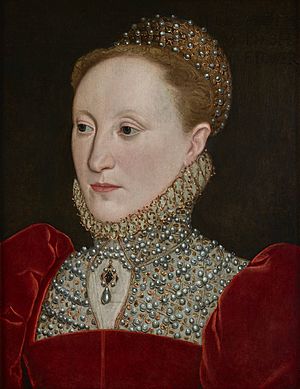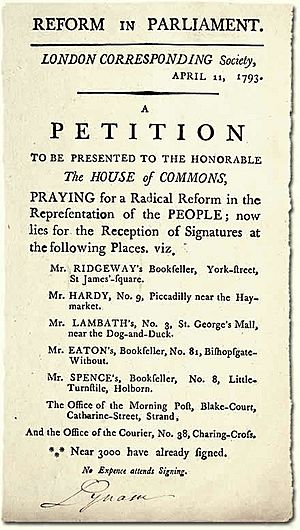Labour movement facts for kids
The labour movement is about working people coming together to improve their lives. It has two main parts:
- The trade union movement (also called the labor union movement) is when workers join groups called trade unions. These unions help workers speak up together for better working conditions, fair pay, and good treatment from their bosses and governments.
- The political labour movement often includes a political party (like a "labour party" or "workers' party"). These parties work to represent the interests of employees in government.
The labour movement started because of the big changes during the Industrial Revolution in the late 1700s and early 1800s. This was when many jobs moved from farms and small home workshops to large factories.
Contents
History of the Labour Movement
How the Labour Movement Began
The labour movement started in Europe during the Industrial Revolution (around 1760-1830). Before this, many people worked on farms or made things at home. But new machines and factories meant jobs moved to towns. This led to many low-skilled workers and often lower wages.
Before factories, a system called the guild system was common. Guilds were groups that protected workers, owners, and customers by setting rules for wages and prices. But as this system became less fair, workers sometimes teamed up to ask for better pay. These early groups were like the first steps towards modern trade unions.
Early Worker Groups (1500s-1700s)

In England, in the 1500s, the government started to control wages instead of the guilds. For example, the 1562 Statute of Artificers gave local officials the power to set wages. This law was meant to make sure workers earned enough to live.
However, by the mid-1700s, the government started to stop controlling wages. They began to believe in "laissez-faire" economics, which means letting businesses run without many rules. Because of this, workers' wages often went down while food prices went up. This made workers realize they needed to organize themselves to protect their interests.
The 1700s: Workers Unite
There aren't many records of lasting trade unions before the 1700s. But from 1700 onwards, workers in the United Kingdom started to "combine" (team up) to ask for higher wages. These early unions were usually small and only for specific jobs or areas.
Workers would go on strike, talk to their employers together (called collective bargaining), or ask the government for help. Some of the first groups to do this were wool workers and knitters. In 1718, the King even made a statement against workers forming groups to change wages. But workers kept organizing anyway.
Strikes and protests happened in many places. For example, miners in Norwich went on strike several times. Knitters in Nottingham also protested. Sometimes, strikers would break machines to make their point quickly. In 1751, wool-combers formed a union that helped members who were out of work.
Workers also used social clubs, like craft clubs or friendly societies, as a way to secretly organize union activities.
In politics, people like John Wilkes became popular by speaking up for workers. He wanted more people to be able to vote and an end to corruption. When he was put in prison, his supporters protested, and some were shot by the government in 1768.

After the French Revolution in 1789, new ideas about workers' rights spread. Thomas Paine's book The Rights of Man (1791) was very popular. The London Corresponding Society, a group for working-class people, started in 1792 and grew quickly.
The British government was worried about these new ideas. They cracked down on protests and made laws to stop public gatherings. In 1799, the Combination Act made it illegal for workers to form unions. This was a big challenge, but workers still found ways to organize, even if it was against the law.
The 1800s: Big Changes and Challenges
In the early 1800s, strikes continued. For example, weavers in Glasgow went on strike in 1805. In 1808, after a bill to set a minimum wage failed, workers in Manchester went on a large strike. More than 15,000 weavers protested, leading to some violence. They eventually won a 20% wage increase.
In 1811, the Luddite movement began in Nottinghamshire. Workers, upset about their low living standards, started destroying textile machines. Because the movement was secret, the leaders were never caught, and employers had to raise wages.
After the Napoleonic Wars ended in 1815, the economy got worse. Taxes were high, unemployment grew, and food prices stayed high. This led to more protests. New working-class newspapers became popular, and political clubs called Hampden Clubs were formed.
In 1816, a group of protesters tried to take over the Tower of London. This led the government to pass new laws in 1817, called the Gagging Acts, which limited public gatherings and free speech. In protest, workers tried to march to London in the Blanketeers march, but they were stopped by the military.
The government also started using spies to cause trouble and turn public opinion against workers. One famous case was Oliver the Spy, who encouraged an uprising that led to executions.

Despite these efforts, the labour movement kept growing. In 1819, a huge protest happened in Manchester, known as the Peterloo Massacre. About 80,000 people gathered peacefully to support political reforms. But soldiers attacked the crowd, killing 18 people and injuring many more. The government responded with even stricter laws.
However, things started to change. In 1824 and 1825, laws were passed that made unions legal again, though some union actions were still limited.
Chartism: A Mass Movement
Chartism was a huge working-class movement in England from 1838 to 1848. It was named after the People's Charter of 1838, which asked for six main things:
- All men aged 21 and over should be able to vote.
- Voting should be secret.
- Voting areas should be equal in size.
- Members of Parliament should be paid.
- People shouldn't need to own property to be in Parliament.
- Parliament should be elected every year.
Even though Chartism eventually faded, Britain later adopted five of these six reforms. This showed how important the movement was.
In 1864, the International Workingmen's Association was formed in London. This was the first attempt to connect workers' movements around the world. Key goals included workers' right to organize and an 8-hour workday. From the mid-1800s onwards, the labour movement became more global.
The Catholic Social Teaching tradition also gave a big boost to the movement. In 1891, Pope Leo XIII wrote Rerum novarum, which supported ideas like limits on work hours, fair wages, ending child labour, and workers' right to form unions.
In Britain, "new unionism" started in the 1880s. These unions were open to many different kinds of workers, including those without special skills, like dock workers. They kept their fees low to encourage more people to join.
Thanks to the labour movement around the world, many important changes have happened. These include:
- The two-day weekend
- The minimum wage
- Paid holidays
- The eight-hour day
People like Mary Harris Jones ("Mother Jones") and the National Catholic Welfare Council were very important in the fight to end child labour in the United States in the early 1900s.
Labour Parties
Modern labour parties grew out of the organizing efforts of workers in Europe and other parts of the world in the 1800s. The Chartist movement in the UK (1838–48) was one example.
In Australia, local labour parties were formed by trade union members in the late 1800s. In 1899, the Labour Party in Queensland briefly formed the world's first labour government. After Australia became a country in 1901, several labour parties joined together to form the Australian Labor Party (ALP).
The British Labour Party was created in 1900. These parties are often made up of union representatives and other members who support workers' rights.
Labour Festivals
Labour festivals have always been a part of the labour movement. These events are often held outdoors in the summer. They include music, talks, food, and films, attracting many people each year. A labour festival is a yearly gathering for unions to celebrate their achievements, find solutions to problems, and discuss unfair actions by employers or the government.
Labour and Fairness for All
In places like New Orleans, Louisiana, in the early 1900s, black and white dockworkers sometimes worked together. Even though they had separate unions based on race, they teamed up to make demands to their employers. They agreed to have mixed work crews (50% black and 50% white) and to ask for the same wages. This stopped ship owners from trying to turn one race against the other. They also worked together during big strikes.
Martin Luther King Jr. once said in 1961 that the needs of African Americans were the same as the needs of workers: fair wages, good working conditions, decent homes, and security for old age. He noted that those who dislike labour movements often also speak against racial equality.
Labour Movements Around the World
Most labour laws are set by individual countries. While there are some efforts to create international labour standards through the International Labour Organization (ILO), it's hard to enforce them globally. Because of this, labour movements have often grown differently in each country.
However, with more international trade and big global companies, there's a growing need for workers to cooperate across borders. Many international union organizations have been created to help unions work together, share information, and support workers' interests worldwide.
List of National Labour Movements
- Trade unions in Albania
- Trade unions in Algeria
- Trade unions in Argentina
- Australian labour movement
- Trade unions in Egypt
- Trade unions in Germany
- Trade unions in India
- Trade unions in Ireland
- Labour unions in Japan
- Trade unions in Malaysia
- Trade unions in South Africa
- Trade unions in Spain
- Swedish labour movement
- Trade unions in Switzerland
- Labour movement in Taiwan
- Trade unions in the United Kingdom
- Labor unions in the United States
Images for kids
-
The Apprentice Laws, which regulated wages and employment and were passed during the reign of Queen Elizabeth I, lasted in England until the early 19th century, but were becoming increasingly dead letter by the mid 18th century.
-
A handbill for the London Corresponding Society, the first political society in Britain focused on working-class politics
-
A contemporary depiction of the Peterloo Massacre which occurred on 16 August 1819
See also
 In Spanish: Movimiento obrero para niños
In Spanish: Movimiento obrero para niños
- AFL–CIO
- Anarchism
- Catholic social teaching
- Child labour
- Class conflict
- Democratic socialism
- Eight-hour day
- Industrial Workers of the World
- International labour law
- Labour law
- Labour history
- List of international labour organizations
- Living wage
- Minimum wage
- New Unionism
- Social democracy
- Trade union




